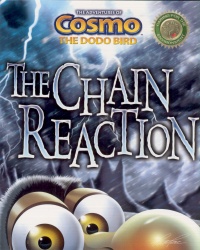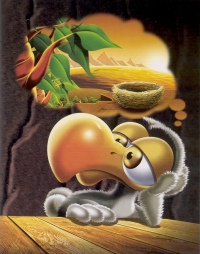| ________________
CM . . .
. Volume XVIII Number 4. . . .September 23, 2011 
 |
The Chain Reaction. (The Adventures of Cosmo The Dodo Bird).
Patrice Racine.
Toronto, ON: Tundra Books, 2011.
112 pp., pbk., $12.99.
ISBN 978-1-77049-244-8.
Grades 3-6 / Ages 8-11.
Review by Meredith Cleversey.
*** /4
|
| |
|

excerpt:
We nearly wept when we reached the lake and saw what the storm had done. The beach was gone; the ground around the lake was soggy. The water was murky and clogged with debris.
In silence, we left the lake and entered what had once been a cool, green forest. Most of the trees were uprooted. I touched a trunk, and the bark crumbled beneath my fingers. Everything was covered in a thick layer of dried mud.
In the distance, even the highest mountain had not been spared by the storm. Mudslides scarred the mountainsides.
I couldn't bear the sight of it. "The traveling planet has been totally destroyed."
The Chain Reaction is the fourth book in "The Adventures of Cosmo the Dodo Bird", a series of books which were developed and illustrated by Patrice Racine and written by Joannie Beaudet and which were designed to inspire young environmentalists everywhere. Cosmo is the last surviving dodo bird, a species of bird that lived on Earth 300 years ago. With his robot-spaceship friend 3R-V, Cosmo travels to foreign planets to explore and look for other dodo birds, and, in the process, Cosmo makes new friends in the two-heads (Left and Right), Fabrico and Diggs. This group settles on a planet called the traveling planet, and there they find a remote control that controls the climate. Everyone has ideas for how to use the remote, and, ultimately, the climate is tampered with so much that the situation becomes disastrous. As The Chain Reaction begins, the remote has been lost, and the climate is totally out of control. As tornados, tsunamis, snow storms, and other natural disasters slam the planet, Cosmo and his friends try to find safety and are forced to consider whether they will be able to stay on their new home, or if the planet will be completely destroyed.
 The Chain Reaction is an extremely fast-paced adventure, full of environmental action and dire situations. For the reader who likes quick plots without a lot of detail, this book provides a continuously exciting story. However, for the reader who enjoys a bit more detail in a work, The Chain Reaction may be a little too fast-paced. For example, in the span of less than three pages, the two-heads warn of an oncoming tsunami, the giant wave hits and engulfs Cosmo, endangers his life, and then completely disappears. While there is definitely no shortage of adventure in this story, the lack of description and quick jump from one event to the next might be a little much for some readers. The Chain Reaction is an extremely fast-paced adventure, full of environmental action and dire situations. For the reader who likes quick plots without a lot of detail, this book provides a continuously exciting story. However, for the reader who enjoys a bit more detail in a work, The Chain Reaction may be a little too fast-paced. For example, in the span of less than three pages, the two-heads warn of an oncoming tsunami, the giant wave hits and engulfs Cosmo, endangers his life, and then completely disappears. While there is definitely no shortage of adventure in this story, the lack of description and quick jump from one event to the next might be a little much for some readers.
One of the most stunning aspects of this series is the artwork, graphic design illustrations done by the creator of the series, Patrice Racine. The images are dynamic, taking up full pages of the book, and the illustrations draw the reader in, mingling with the text to create a level of complexity in the story. Occasionally, there are also graphic text exclamations such as "BANG!" within the illustrations, which can, at times, make this book seem a little like a graphic novel. The illustrations add a lot of drama to the scenes described in the text, especially since some of the events happen rather quickly. While the text may be lacking somewhat in description, the illustrations add depth to the tale and allow the reader to see exactly what is going on.
The concept behind this book, as well as the entire "The Adventures of Cosmo the Dodo Bird" series, is to promote a caring for the environment. This story is definitely all about the climate; the havoc created by the carelessness of the friends when using the remote control is immense, and the characters are forced to endure earthquakes, ice storms, rock slides, and other dangers. These concepts are introduced in a simple, easy-to-understand way, and the underlying message that the friends neglected the environment and must work to restore it after the massive storms have finally subsided, is very clear. However, the fact of the story is that the climate changes are brought on by a remote control, a situation very different from life on Earth. The weather also changes so quickly from one disaster to the next that it is somewhat difficult to really grasp what is going on. As soon as something occurs (such as the tsunami), it is gone again, and there is no real explanation of what caused the event or what the disaster really is, as it relates to planet Earth. At the end of the story, the friends, about to abandon the planet, realize that some flowers managed to survive the storms. The book says that the characters had to work to restore their planet, but, in all actuality, the planet really restores itself.
The Chain Reaction is a good story that deals with some major components of natural disaster, all wrapped up in a tale of friends trying to keep together and survive. The environmental aspect of the story is definitely present, and the message of caring for the environment is certainly clear. However, this book should not be considered a guide on caring for the environment. The characters in this book live on another planet and are faced with a different situation of a remote control gone haywire. This story does not teach much about the natural disasters themselves or how their existence can be related to life on Earth. However, as a story, The Chain Reaction provides an exciting adventure that has the underlying message of being careful and caring for what is around us all.
Recommended.
Meredith Cleversey is currently completing her Masters of Library and Information Science in London, ON. She loves to read, write, and live in a world of pure imagination.

To comment
on this title or this review, send mail to cm@umanitoba.ca.
Copyright © the Manitoba Library Association. Reproduction for personal
use is permitted only if this copyright notice is maintained. Any
other reproduction is prohibited without permission.
NEXT REVIEW |
TABLE OF CONTENTS FOR THIS ISSUE
- September 23, 2011.
AUTHORS |
TITLES |
MEDIA REVIEWS |
PROFILES |
BACK ISSUES |
SEARCH |
CMARCHIVE |
HOME |

 The Chain Reaction is an extremely fast-paced adventure, full of environmental action and dire situations. For the reader who likes quick plots without a lot of detail, this book provides a continuously exciting story. However, for the reader who enjoys a bit more detail in a work, The Chain Reaction may be a little too fast-paced. For example, in the span of less than three pages, the two-heads warn of an oncoming tsunami, the giant wave hits and engulfs Cosmo, endangers his life, and then completely disappears. While there is definitely no shortage of adventure in this story, the lack of description and quick jump from one event to the next might be a little much for some readers.
The Chain Reaction is an extremely fast-paced adventure, full of environmental action and dire situations. For the reader who likes quick plots without a lot of detail, this book provides a continuously exciting story. However, for the reader who enjoys a bit more detail in a work, The Chain Reaction may be a little too fast-paced. For example, in the span of less than three pages, the two-heads warn of an oncoming tsunami, the giant wave hits and engulfs Cosmo, endangers his life, and then completely disappears. While there is definitely no shortage of adventure in this story, the lack of description and quick jump from one event to the next might be a little much for some readers.